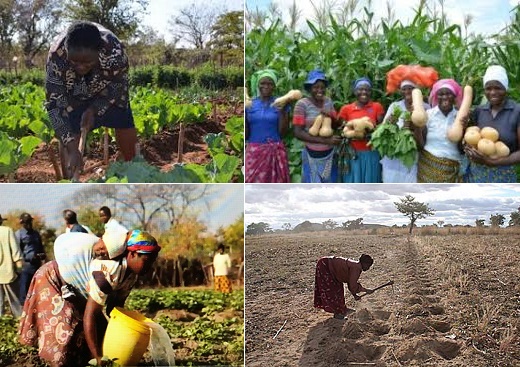 Zimbabwe is experiencing more hot and fewer cold days than before as a result of climate change and climate variability. The country’s annual mean surface temperature has warmed by about 0.40C from 1900 to 2000.
Zimbabwe is experiencing more hot and fewer cold days than before as a result of climate change and climate variability. The country’s annual mean surface temperature has warmed by about 0.40C from 1900 to 2000.
Zimbabwe’s third National Communication to the United Nations Framework Convention on Climate Change (UNFCCC) asserts that the period from 1980 to the present has been the warmest since the country started recording its temperature. In addition, rainfall and its timing are increasingly becoming uncertain. This is a very negative scenario for an agriculture-based economy such as Zimbabwe, with over 70 per cent of the population living in rural areas and dependent on climate-sensitive livelihoods such as arable farming and livestock rearing, among others.
The livelihoods of the people of Zimbabwe depend on vulnerable natural resources; for example, people in the Tsholotsho District have relied on gathering mopane worms (caterpillars) for generations. It was a lucrative livelihood option that enabled them to marry and take children to school, among other things. With climate change, that enterprise is being threatened: the mopane worms are no longer in abundance due to reduced rainfall, impoverishing people dependent on that livelihood option.
In addition, thatch grass harvesting and selling has also been affected by climate change. Reduced rainfall also affects the growth and quality of the grass to be sold. Rural communities use grass for thatching their huts, as some of the households cannot afford zinc and asbestos sheets. Some women sell the grass as a livelihood activity, so the change in availability has negative implications for income-generating projects for Zimbabwean women. The depletion of these resources as a result of climate change will lead to further poverty and affects the country’s efforts towards sustainable development. Climate change is thus an additional constraint to sustainable socioeconomic development for Zimbabwe.
Zimbabwe’s Climate Policy and National Adaptation Plan

In an effort to reduce the country’s vulnerability, Zimbabwe developed its National Climate Change Response Strategy in 2015, its National Climate Policy in 2017 and a climate-smart agriculture manual for agricultural colleges in 2017.
Zimbabwe’s National Adaptation Plan (NAP) was launched in 2015 through a project called Scaling Up Climate Change Adaptation through Integrated Planning Systems (IPS) between 2016–2018. It follows the National Climate Policy, which has set the pace for an enabling environment for NAP development. However, NAP development has been slow due to limited financial support. The IPS scope was targeted at three districts—Buhera, Chiredzi and Chimanimani—and therefore could not anchor the NAP development process. However, through the Green Climate Fund’s (GCF) NAP Readiness support, the country will develop a wholly country-owned NAP that is gender-responsive and participatory to ensure no one is left behind.
Institutional Arrangements for NAP Development
Institutional coordination in adaptation planning remains a key issue that needs to be addressed in Zimbabwe. The coordinating department has yet to be decentralized to the grassroots level. As such, the department has relied on technical support from other line ministries and parastatals such as the Environmental Management Agency, the Department of Civil Protection and United Nations volunteers.
Working Toward a Gender-Responsive NAP Process
Incorporation of the views of women and taking cognoscenti of gender considerations in a patriarchal society will be critical in developing a gender-responsive adaptation plan. Expectations that women take on certain gender roles such as fetching firewood and water for domestic purposes worsens the plight of many women, and this is compounded by climate change, as women have to walk for longer distances to complete these tasks.
However, in a changing climate, women are proving that, instead of being just victims of climate change, they are also agents of change. They are championing climate-smart farming practices that include solar-powered nutrition garden farming, and have consequently managed to protect their households from hunger and malnutrition while having surplus to sell.
Building Capacity on Adaptation
Adaptation planning is complicated by coming at a time when the country has limited capacity to conduct vulnerability and adaptation assessments that should underpin policy formulation. This is further exacerbated by the shifting of agro-ecological regions, meaning that the situations described in past assessments may have changed. Studies by Mugandani et al. (for example, “Re-classification of agro-ecological regions of Zimbabwe in conformity with climate variability and change”) showed evidence towards a shift in agro-ecological regions, which will affect thousands of livelihoods, requiring urgent steps be taken to mitigate further climate shocks.
Next Steps for Zimbabwe’s NAP Process
The National Climate Policy for Zimbabwe calls for policy coherence in order to ensure effective mainstreaming of climate change in all socioeconomic sectors of the economy. While awareness-raising workshops and sensitization forums have been held, climate change awareness is far from realizing the desired behavioural change. In an effort to advance its NAP process, the country will hold a national validation meeting in the second week of October 2018 to assure quality and endorse the findings of the stocktaking report for NAP process. This key document, once endorsed, will form a reference document for NAP development.
In the coming months, the Government of Zimbabwe will be working with the NAP Global Network to develop a NAP Road Map. In order to advance this process and achieve the milestones set out in this Road Map, the country urgently requires social, technological and financial resources in order to adapt to climate change.
Any opinions stated in this blog post are those of the author and do not necessarily reflect the policies or opinions of the NAP Global Network, its funders, or Network participants.